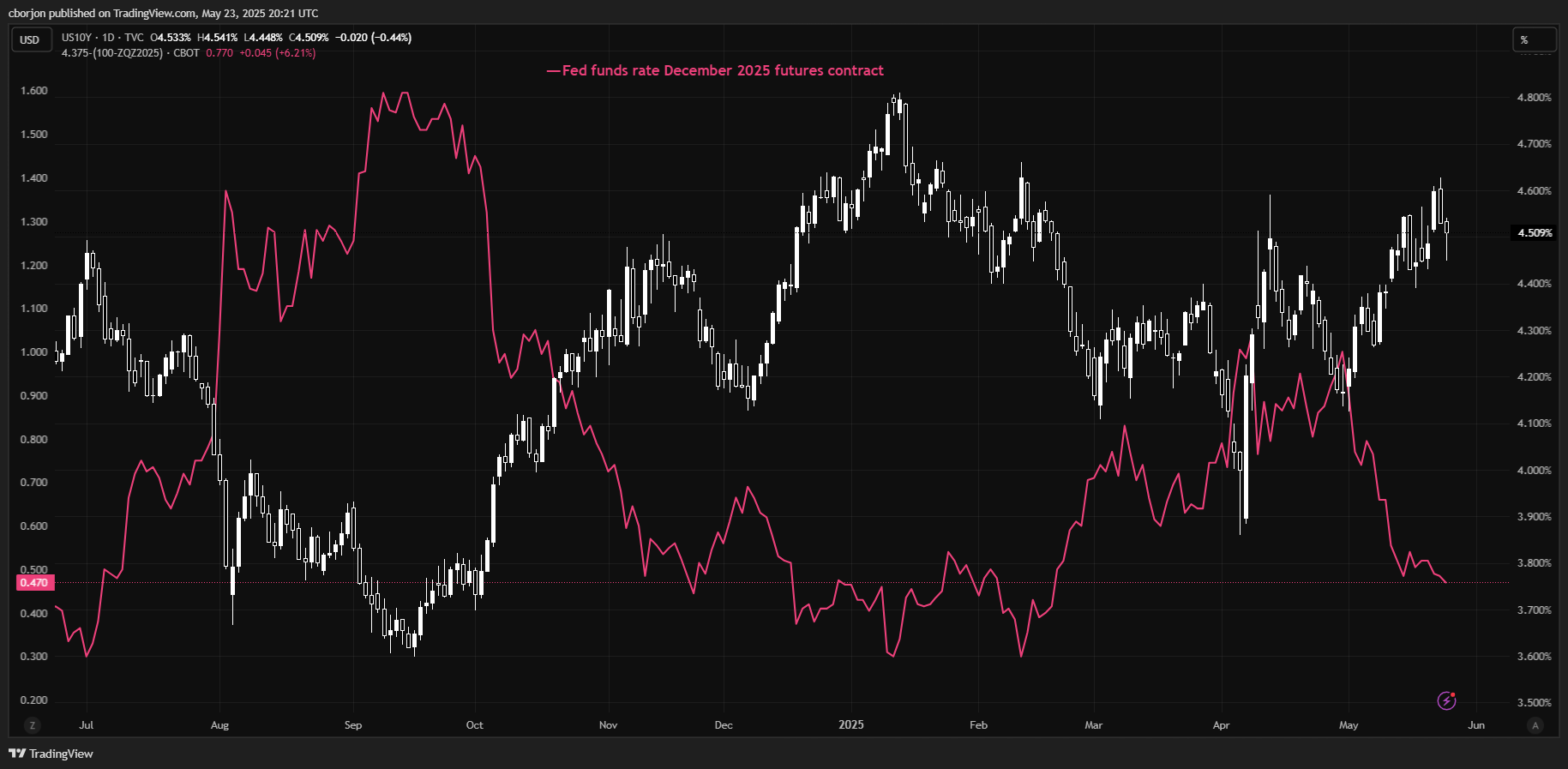- 10 -year yield falls to 4.51% while investors flee from US assets in the midst of growing protectionist risks.
- Trump points to the iPhones manufactured abroad and threatens 25% tariffs on Apple products.
- The reduction of Moody’s, the fiscal invoice of 3.8 billion dollars and commercial tensions with the EU intensify fiscal and inflationary fears.
The yields of the US Treasury bonds fall throughout the curve after Trump’s threats to impose tariffs on Apple iPhones not manufactured in the US and on the products imported from Europe. At the time of writing, the 10 -year Treasury note of the US has dropped two basic points to 4,509%.
Treasury yields fall throughout the curve while Apple tariff threats and the EU deepens concerns about the US trade war and debt.
Trump’s tariff rhetoric weighed on US assets as the tendency to “sell America” strengthened. The commercial war, which Trump began, and the concerns about the fiscal position of the US causes outputs of shares, bonds and the US dollar.
The escalation of the commercial war, now against Apple, a company based in the United States, shook the US stock market rates, which remained pressured before the closing of Wall Street. Trump is threatening Tim Cook’s company, saying that any iPhone sold in the US but not manufactured in the country would have to pay 25%tariffs.
In addition, he climbed the already difficult discussions with the European Union, saying that he recommended 50% tariffs on EU imports from June 1.
The yields of the American bonds had retired something, after an increase sponsored by the moody’s reduction of US debt, citing concerns about fiscal improvement and fears that inflation remained high due to tariffs.
Meanwhile, the US House of Representatives approved Trump’s fiscal bill, which is now on the way to the Senate to be discussed and voted.
The bill would add about 3.8 billion dollars to the already growing national debt. Meanwhile, the US Treasury bonus yield performance rose above 5% due to the effects of a deterioration of US tax perspectives.
10 -year performance of the US vs. Fed fund rate Relaxation expectations December 2025

US interest rates
Financial institutions charge interest rates on loans to borrowers and pay them as interest to savers and depositors. They influence the basic types of interest, which are set by central banks based on the evolution of the economy. Normally, central banks have the mandate to guarantee the stability of prices, which in most cases means setting as an objective an underlying inflation rate around 2%.
If inflation falls below the objective, the Central Bank can cut the basic types of interest, in order to stimulate credit and boost the economy. If inflation increases substantially above 2%, the Central Bank usually rises the interest rates of basic loans to try to reduce inflation.
In general, higher interest rates contribute to reinforce the currency of a country, since they make it a more attractive place for world investors to park their money.
The highest interest rates influence the price of gold because they increase the opportunity cost of maintaining gold instead of investing in an asset that accrues interest or depositing effective in the bank.
If interest rates are high, the price of the US dollar (USD) usually rises and, as gold quotes in dollars, the price of low gold.
The federal funds rate is the type to a day that US banks lend each other. It is the official interest rate that the Federal Reserve usually sets at its FOMC meetings. It is set at a fork, for example 4.75%-5.00%, although the upper limit (in this case 5.00%) is the aforementioned figure.
Market expectations on the interest rate of the Federal Reserve funds are followed by the Fedwatch of the CME tool, which determines the behavior of many financial markets in the forecast of future monetary policy decisions of the Federal Reserve.
Source: Fx Street
I am Joshua Winder, a senior-level journalist and editor at World Stock Market. I specialize in covering news related to the stock market and economic trends. With more than 8 years of experience in this field, I have become an expert in financial reporting.





